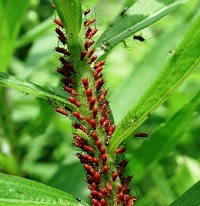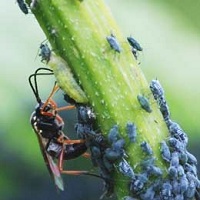Aphis species
Hosts
All trees and shrubs
Appearance and Life Cycle

Photo credit: Wikimedia

Photo credit: small-farm-permaculture-and-sustainable-living.com
Aphids, commonly known as plant lice are small, pear-shaped, fragile insects. They can be black, red, green, yellow or colorless, with some species being covered with long, white, waxy threads. Aphids may be winged or wingless and measure 1 to 3 millimetres (mm) in length. They can usually be identified by a pair of short, tube-like projections near the rear of the abdomen. Aphids have long antennae and slender legs and are equipped with piercing/sucking mouthparts. The life cycle of most aphids is complicated with many variations and exceptions.
Damage
Aphids cause damage by piercing the tender plant tissue and drawing large quantities of plant sap. They may be found feeding on any part of the host including: the foliage, buds, flowers, fruit, twigs and roots. They often feed in groups. Aphids can cause galls, curled leaves, swollen branches, and discolored or wilted leaves. They usually do not cause permanent damage to forest, shade and ornamental trees. Some aphids excrete excessive amounts of a sticky substance called honeydew. This honeydew can be extremely annoying when it is deposited on sidewalks, cars and other objects. Honeydew attracts insects such as ants, bees, flies and wasps, whose presence may be the first sign of an aphid infestation.
Control
Aphids have many natural enemies including lady beetles and birds. Weather conditions such as heavy rains or cold temperatures are major factors in reducing aphid populations. However, under favorable conditions, aphid populations can rapidly increase and may require chemical control. Insecticides registered for control of aphids include: malathion, diazinon, dimethoate, or permethrin. Before applying any insecticide check for predators, the amount of aphid damage and make sure the insecticide is not toxic to the plant.